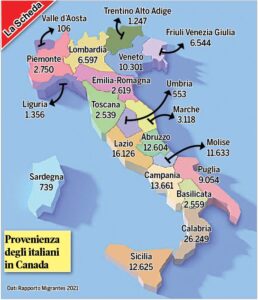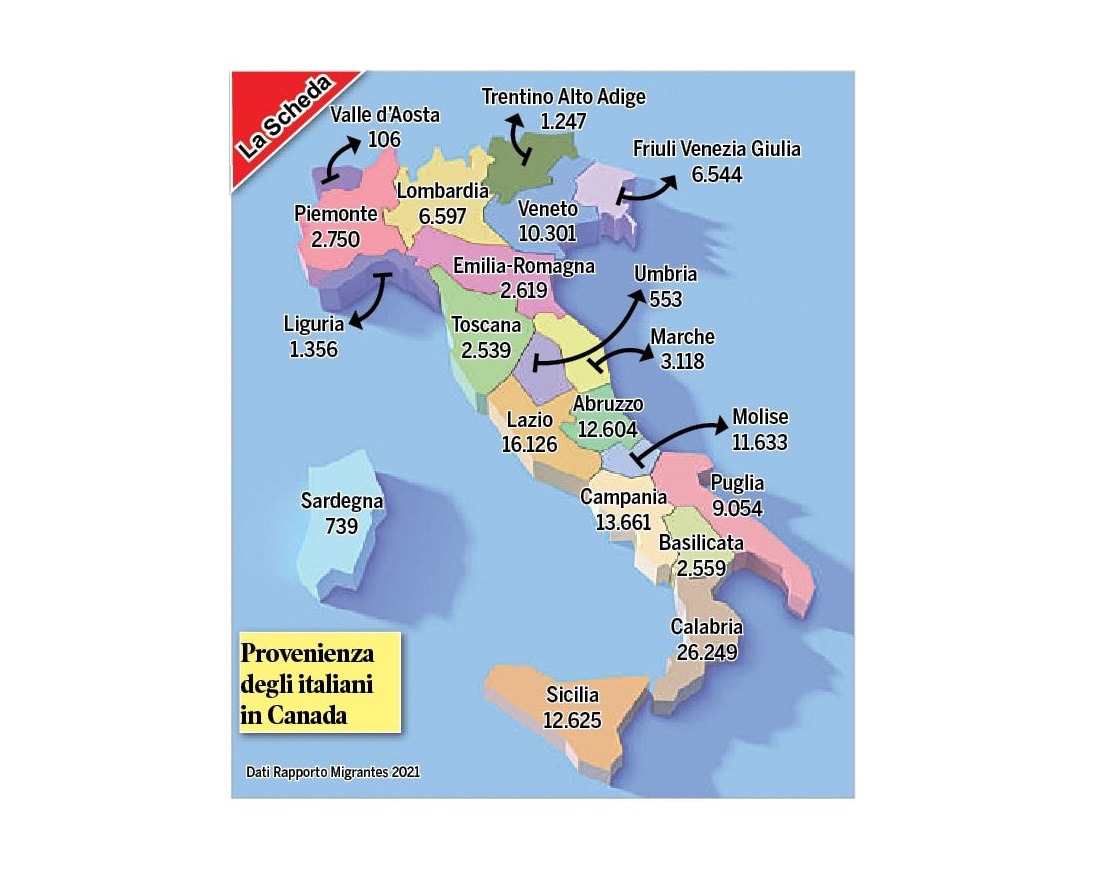Italians in Canada: Calabria, Lazio and Campania on the podium

TORONTO – Nearly 143,000 Italians reside in Canada, with Calabria, Lazio and Campania as the most represented regions. This is revealed by the Migrantes Report, a precious tool that every year analyzes the Italian migration phenomenon and that studies, Nation by Nation, the main trends that characterize immigration and emigration from the Belpaese.
The data in the study relate to Italians still in possession of citizenship who are registered with Aire, the Registry of Italians residing abroad. From StatsCan data we know that over 1.5 million Italian Canadians live in Canada, so with a certain approximation we can say that in our country one Canadian of Italian origin out of ten is still in possession of an Italian passport.
According to the 2021 report, which examines the numbers of the previous year, in all there are 5,652,080 Italians residing abroad, equal to 9.5 percent of the entire Italian population of 59,257,566. Argentina is once again the country that hosts the largest number of Italians, 884,187, followed by Germany (801,082) and Switzerland (639,508). Next are Brazil, France, Great Britain, the United States, Belgium, Spain and Australia, with Canada ranking eleventh in this special ranking.
In our country Calabria is once again the region with the highest number of members of the Aire, as many as 26,249, followed by Lazio (16,126) and Campania (13,661). So we find the other regions that have historically fueled the migratory phenomenon in Canada: Sicily with 12,625 members of the Aire, Abruzzo (12,604), Molise (11,633) and Veneto (10,301).
The ranking continues with Puglia (9,054), Lombardy (6,597), Friuli Venezia Giulia (6,544), Marche (3,118), Piedmont (2,750), Emilia Romagna (2,619), Basilicata (2,559) and Tuscany (2,539).
To close Liguria (1,356), Trentino Alto Adige (1,247), Sardinia (739), Umbria (553) and Valle D’Aosta (106).
A detailed analysis of the data in the Migrantes Report also allows us to understand some key trends in the migration phenomenon of Italians in Canada. According to the study, 57.8 percent of Italians in our country enrolled in air for expatriation, 28.8 percent by birth, 7.4 percent by re-registration and 0.9 percent by transfer.
A second essential indicator is that relating to the seniority of registration in the Registry of Italians residing abroad, a value that confirms how the Italian migration phenomenon to Canada has been massive in the past and then slowed down strongly in recent years. In all, 60.2 percent of Italians residing in Canada have been enrolled in Aire for more than 15 years, while 15.5 percent enrolled 10 to 15 years ago. 11.9 percent enrolled 5 to 10 years ago, 5.1 percent 3 to 5 years, 5.4 percent 1 to 3 years and 1.9 percent one year.
To better understand this dynamic it is necessary to make a comparison with another country that has instead seen the Italian migration phenomenon remain constant even in recent years.
In Great Britain, for example, 32 percent of the 412,000 Italians residing there enrolled in Aire more than 15 years ago, 11.1 percent in a period between 10 and 15 years, 15.9 percent between 5 and 10 years, 12.4 percent from 3 to 5 years, 17.3 percent from 1 to 3 years and 11.3 percent in the last year. This data shows how in the United Kingdom there is a large Italian community that has resided there for a long time and how, at the same time, the migration phenomenon from the Balpaese has been extremely significant even in recent years. This figure is in sharp contrast with that of Canada, where in the last decade we have witnessed a cooling of overall arrivals from Italy.



